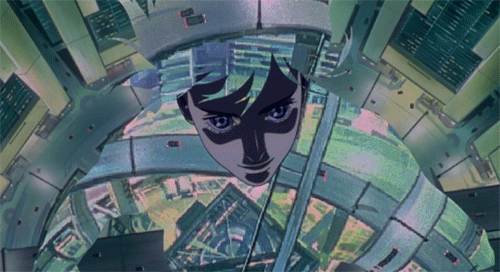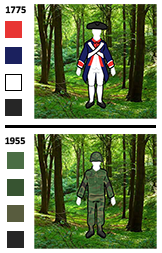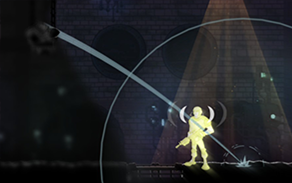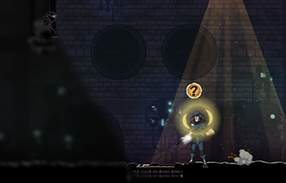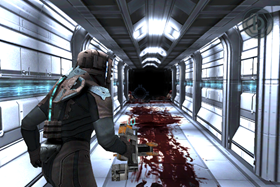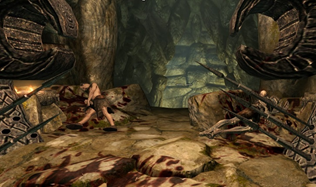Camouflage and Feedback in Video Games
Introduction
|
I played Tom Clancy's The Division a lot. As my friends couldn't match my rhythm, I used to spend many hours roaming alone in the Dark Zone. Yet, it constituted a quite painful experience: groups of players never hesitate to assault you and single players are greatly encouraged to do so as soon as you are looking away. The more I was playing, the more I developed habits to remain as invisible as possible from other players and realized these habits were directly inspired by my training as an Alpine Hunter in the French Army. Of course, I can’t speak about some aspects dealing with squad tactics and overall strategy as it would transgress military NDAs. However, camouflage techniques are worldly known and most specialized websites already speak about it. I would like today to share this knowledge and make a short assessment about how video games exploit it to create stealth gameplay or – at the contrary – deliberately ignore it to provide better feedback. |
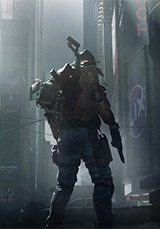 |
A bit of History
Wikipedia defines the camouflage as « the use of any combination of materials, coloration, or illumination for concealment, either by making animals or objects hard to see (crypsis), or by disguising them as something else (mimesis) ».
Most animal species have acquired crypsis or mimesis during Evolution to avoid getting spotted by predators or prey. There are few examples of military use of camouflage before the 19th century – the oldest one refers to recon ships painted in venetian blue during the Gallic Wars to better merge into the sea.
During the 19th century, the British Army was the first to officially abandon shimmering uniforms in favor of khaki ones which were more appropriate for the hot climate in its colonies. It turned out to also better conceal its units. However, camouflage techniques only generalized when the French Army formed its own camouflage corps during the First World War. According to Wikipedia, the term camouflage incidentally comes from a Parisian slang term meaning “smoke blown in someone’s face”.
|
|
More recently, camouflage techniques have been greatly improved to face the parallel evolution of detecting devices. For example, ships are now built with special materials preventing heat detection while Canadian uniforms are now procedurally woven to reduce the detection by advanced devices able to recognized pre-defined patterns (CADPAT). |
Principles
The French Army uses the mnemonic term FOMECBOT to teach the main principles of camouflage. Several variations have been established since my duty ended, I will only speak about the original principles I learned. Feel free to contact me if you know the English equivalent, I couldn’t find it.

Shapes and Colors
Principle
|
Former military uniforms were dyed in bright colors to glorify soldiers, and more easily enroll new recruits: pure white, flashy red, royal blue... Yet, each environment is composed of a specific color palette which rarely matches these uniforms, and soldiers were remaining easily identifiable – even in a dense forest. The human shape easily also stands out from the background – no matter the color of our outfit – as we naturally recognize the features of other human beings. This is why most of the uniforms are not only based on a single color matching the environment but also include several patterns to break the human shape. |
Creating stealth gameplay:
 |
 |
|
Metal Gear Solid 3: Snake Eater |
Metal Gear Solid: Peace Walker |
The Metal Gear series is also well-known for his camo devices which makes the player character (almost) invisible in the same way animals uses mimesis. This mechanism is also part of many games such Ghost In The Shell: First Assault or the Aliens vs Predator series. It became some kind of “special mode” obviating most of shape and the colors principles of the camouflage. Yet, restrictions compensate the use of such devices in all these games as becoming invisible offers a considerable advantage – especially in multiplayer games:
- The player character remains clearly visible at short range
- The player character remains invisible only for few seconds, the device being subject to a cooldown
- The player character remains invisible only while idling
- The player character remains easily detectable by infrared devices
- The player character cannot use another item
- The device can be short-circuited with EMP
- ...
Breaking the stealth for better feedback:
The simplest way to emphasize an element of interest consists in painting it in a contrasting color to make it stand out from the scenery. The player consequently can see it from a greater distance and easily guess the element is interactive - even before knowing what the interaction is.
|
I especially like the example of the contaminated bag from Tom Clancy’s The Division that player characters use to stock the items looted in the Dark Zone. Going rogue is always risky - even while playing in a group. Yet, the contamination bag explicitly indicates if a player has looted items and so assaulting him could be rewarding.
As a player trying to remain as invisible as possible, this feature also encouraged me to ignore low-interest items and kept me under pressure while trying to extract high-end ones. Hence a great feeling of risk / reward.
|
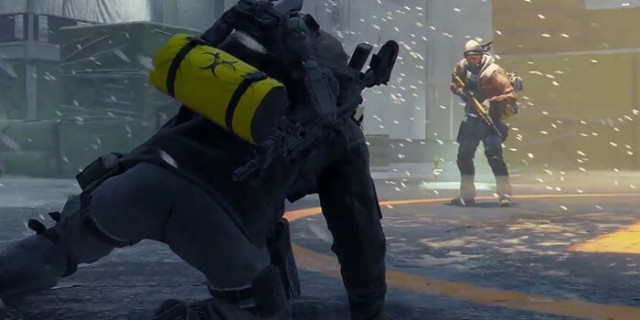 Tom Clancy’s The Division |
Note however that, as Peter Angstadt underlines, allocating a color to an element of interest is usually not enough to reduce the visual confusion. For example, the explosive barrels (red) greatly stand out from the snowed environment but are difficult to see dark interiors. This is why he recommends to also adjust the saturation and the luminosity of each asset.*
Motion, Shadows and Glares
Principle
Although shapes and colors constitute the main principles of camouflage techniques, the other visually-based principles – motion, shadows and glares – should not be underestimated.
|
Concealing doesn’t only concern the body, but also its shadow which can easily betray a soldier’s positions. This is especially true while standing behind a tree or in the corner of a street. Contrary to the popular belief, shadows are also visible in most of interior / night environments. There is always a source of light.
Finally, soldiers often forget that some equipment such as scopes, metallic watches or badges can emit glares by reflecting the light and can catch the enemy attention. Think about Indiana Jones getting spotted on a hill in The Last Crusade.
|
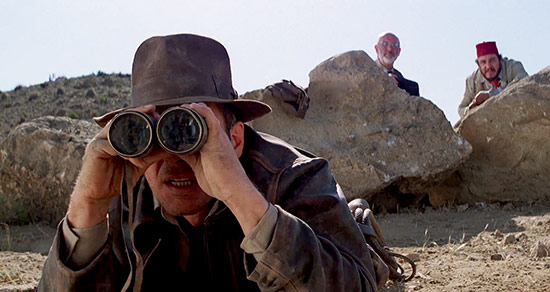 |
|
Indiana Jones and the Last Crusade (1989)
|
Creating stealth gameplay:

Left 4 Dead (click to enlarge)
Track, Hearing, and Smell
Principle
Creating stealth gameplay:
|
Tracks add a temporal dimension to the camouflage. Opponents react while discovering dead bodies, blood pools or snow footprints in most stealth games. It both emphasizes the Level Design while encouraging the player to think twice before acting. Killing a target and vanishing back to a safe position is one thing, slowly transporting his body to a hideout while patrols could spot the player character is another.
Once again, Hitman is an excellent example illustrating original ways to implement such a feature. Hitman: Blood Money greatly encourages the player to remain unnoticed thanks to a notoriety system. A newspaper is displayed at the end of each mission and summarizes the player performance. The overt he plays, the more accurate the identikit is and the harder the game becomes during next missions as opponents would more easily recognize Agent 47 – no matter his disguise.
|
 Hitman: Blood Money |
Hearing in stealth games is logically transposed as a simple radius of sound that can be heard in 360 degrees. According to the complexity of the game, opponents can have one of several radii detecting different sound intensities. It encourages the player to move slower, to preferably use blade or silenced weapons and to avoid noisy surfaces – directly affecting his route.
But hearing can also be easily exploited to distract opponents. Throwing a kunai in Mark of The Ninja, a stone in Far Cry 4, a bottle in Rise of the Tomb Raider or an empty clip in Metal Gear Solid V: The Phantom Pain are indeed easy ways to force an opponent to investigate at a specific position – making him more easy to kill or freeing the way for the character to advance.
|
|
|
As previously stated, animals have better senses than humans. Implementing this in gameplay is always quite tricky: animals should represent a greatest challenge than humans but overly realistic tuning could considerably increase the game difficulty. This is why some games such as Cabela’s Big Game Hunter take in consideration the strength and direction of the wind. The detection radius is then dynamically shaped into a cone and greatly encourages the player either to wait for the wind to shift or to find a better route to approach his prey. This system certainly offers a good alternative but is also quite difficult to expose and requires important real-time feedback.
Breaking the stealth for better feedback:
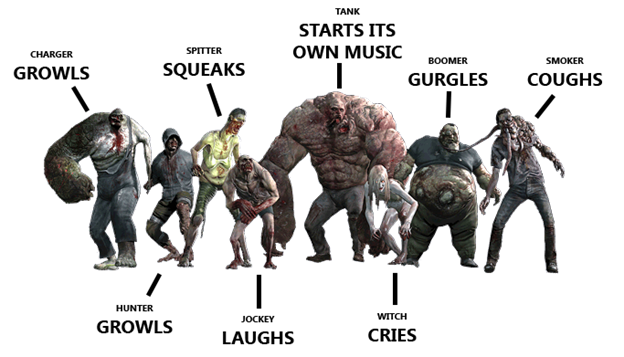
|
|
|
In 2016, Ubisoft revealed the Nosulus Rift – a parodic version of the VR headsets that would make the player able to smell his character farting in South Park: The Fractured But Whole. This obviously was a joke. But think about the gameplay based on the scent that we could create in stealth games: detecting enemies by smelling fire camps, cigarettes, vehicles or trying at the contrary to conceal the player’s own smell while being tracked...
Summary
To summarize, camouflage techniques includes several principles relating to many human senses - not only vision. It only developed as a military discipline from the end of the 19th, century although animals have use it to chase or evade predators since the dawn of time.
Video games obviously use camouflage techniques to emphasize stealth gameplay in its own ways. However, some principles such as the sense of smell still remain quite difficult to transpose as explicit gameplay mechanism.
Designers can also voluntary ignore the camouflage principles to provide further feedback to the player. I strongly recommend taking a look at the following video by Clément Melendez – a French Level Designer – to demonstrate how this feedback is efficiently exploited in F.E.A.R. 2.
